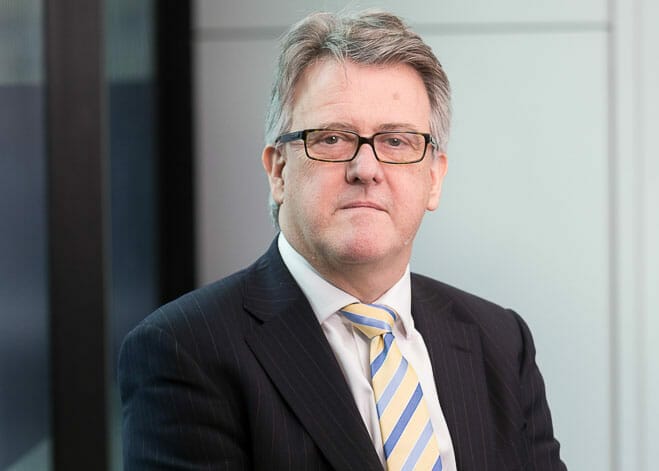Last year, the HSBC pension scheme stepped up the pace on de-risking its £27.5 billion ($36 billion) defined-benefit fund for the bank’s UK employees. It sold more than half of its equity allocation in two equal tranches in June and December, cutting the fund’s exposure to developed market stocks from 17 per cent to 7 per cent and reallocating to long-dated, matching assets.
The pension fund hasn’t publicly revealed its latest funded level yet, but chief investment officer Mark Thompson says it is up from the 102 per cent posted in 2014, and the time was right to take more risk off the table.
“There are no prizes for taking on more risk than you need,” says Thompson, who also oversees the bank’s £3.5 billion ($4.5 billion) fast-growing defined-contribution scheme.
In a strategy that will increasingly replicate an annuity provider, Thompson aims for all the pension fund’s defined-benefit assets to comprise long-dated government bonds, long-dated, high-quality corporate debt and illiquid, long-dated matching assets within the next two or three years.
In the latter, allocations will include more assets in long-lease property, renewable infrastructure and commercial ground rents that throw off a good cash flow, have liability matching characteristics and have a high illiquidity premium.
Around two thirds of the portfolio is in matching assets and third is in the return seeking portfolio comprising equity, private equity, corporate credit, global sovereign credit and European government bonds. Strategy also includes taking out all “unrewarded risk”, which means hedging interest rate, inflation and currency risk.
Thompson predicts the annuity-like strategy will shave 25 per cent off the current running costs of the fund, as management fees fall with the reduction in allocations to return-seeking assets.
“Although we will be paying more for the illiquid portfolio because it is actively managed, the running costs of the scheme will fall as we get closer to this target-matching portfolio,” he says. “Rather than beating up fund managers in terms of costs, the reduction will come from the strategic change in the asset allocation.”
Creating sought-after assets
Building up a portfolio of long-dated matching assets involves a proactive approach to sourcing. Rather than wait for sought-after, illiquid assets to come up for sale, HSBC is creating them itself. An example is its remodelling of a long-held commercial office block in south London into a residential property. The transformation will shift the asset out of the return-seeking portfolio into the matching portfolio.
“We’ve got a tenant going in on a 20-year Retail Price Index (RPI) lease,” Thompson says. “We’ve, in effect, turned the asset into a bond.”
In a similar approach, HSBC is investing in strategies run by Alpha Real Capital. The manager creates opportunities in commercial ground rents by approaching corporations keen to restructure their balance sheet and free up capital by selling off the freehold (the building and the land the property sits on) on a long lease.
“Our manager focuses on [corporations] like nursing homes or hospitals,” Thompson explains. “We get the ground rent from the underlying building and it’s well capitalised. If the business fails, we would own the property; these types of deals don’t exist until they are made.”
All management is outsourced to about 25 managers. Thompson oversees an internal team of three, and is hiring a fourth, who focus on strategy. The ability to build up the matching portfolio rests on strong manager partnerships, relationships that have been built up over time and have adapted to the fund’s changing needs.
HSBC’s property manager LaSalle, for example, used to manage the pension fund’s £1 billion return-seeking property portfolio, which is now morphing into a matching allocation.
“The mandate has changed dramatically from what it was five years ago,” Thompson says. “Our manager relationships are based on understanding what they are good at, and our managers understanding what we need. It evolves through time.”
The dynamic relationship is reflected in other ways, too. When Thompson joined HSBC seven years ago, external managers attended the pension fund’s investment committee meetings, something he stopped because managers’ presence used to crowd out talk on strategic issues. Now, Thompson tends to hold lengthy meetings with his peripheral external managers a couple of times a year in their offices, balanced with much more regular contact – weekly in some cases – with his core managers.
“The job of my team is setting strategy like a conductor of an orchestra and then making sure all the fund managers play instruments correctly,” Thompson says.
HSBC’s fund managers are also an important source of innovation, evident in the scheme’s adoption in 2016 of a multifactor global equities index fund that incorporates a climate tilt. HSBC designed and funded the vehicle, which is managed by Legal & General Investment Management.
“We will come up with half an idea, the consultants have half an idea and the managers will add to it, and between us all it ends up being a good idea,” Thompson explains. “The kernel of a good idea always gets polished up by discussing it with our fund managers.”
Fees are constantly under review, but he doesn’t believe “in going to a manager every five minutes” to hammer down fees. Once a year, Thompson takes details of management fees to his investment committee for approval.
Governance allows much-needed agility
The de-risking trajectory requires an ability to act quickly, something HSBC’s governance allows. When the fund decided to reduce the developed-market equity allocation from 17 per cent to 7 per cent last year, the first 5 per cent was taken out after just one board meeting.
“We had a board meeting; it was agreed that it was too important to wait until the next meeting, so we did it,” Thompson recalls. “If I need an investment committee meeting, I can have one straightaway as long as everyone is around. I don’t want our investment process confined to a quarterly cycle, because we might need to react quickly and need flexibility in the system.”



